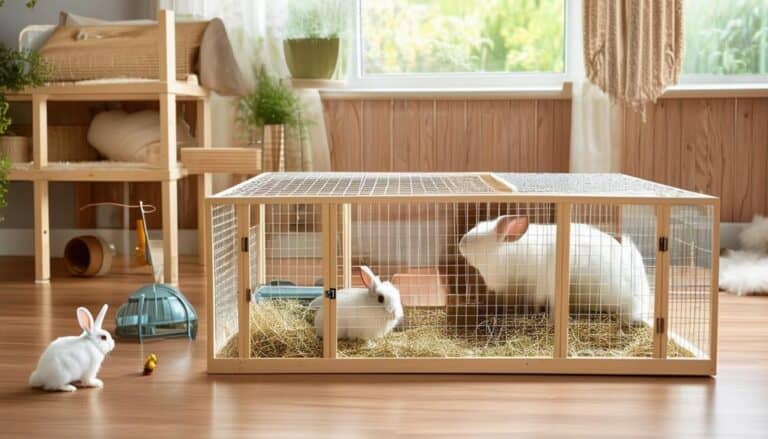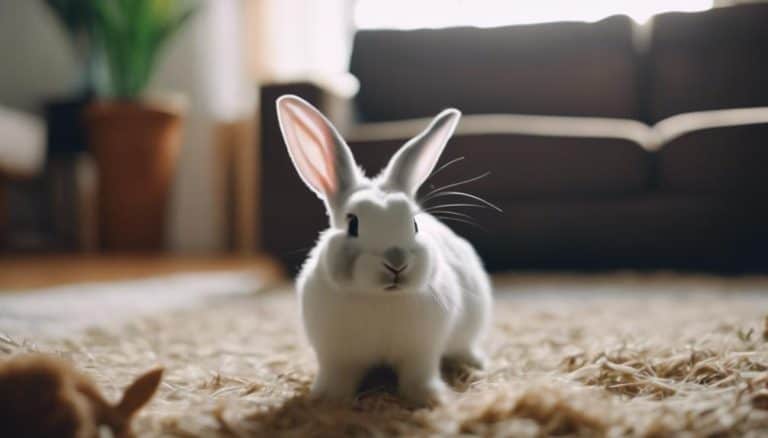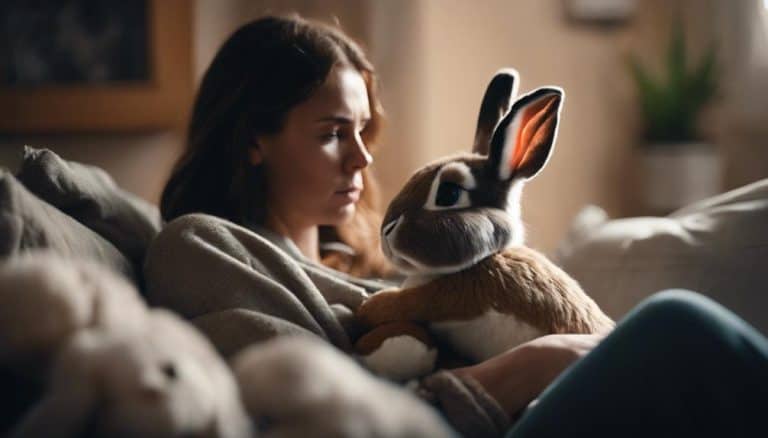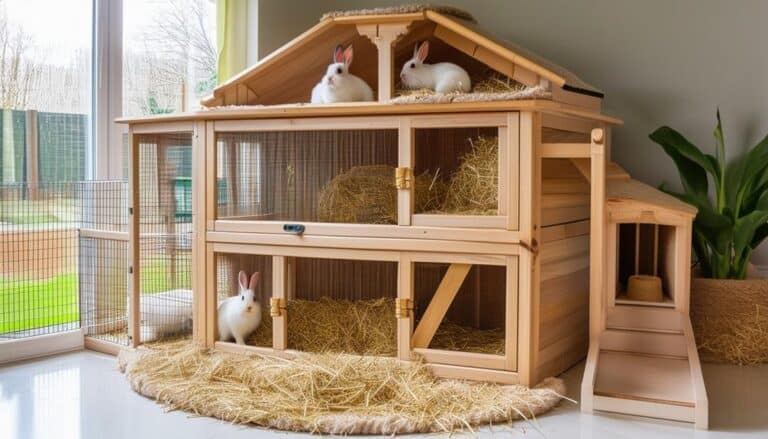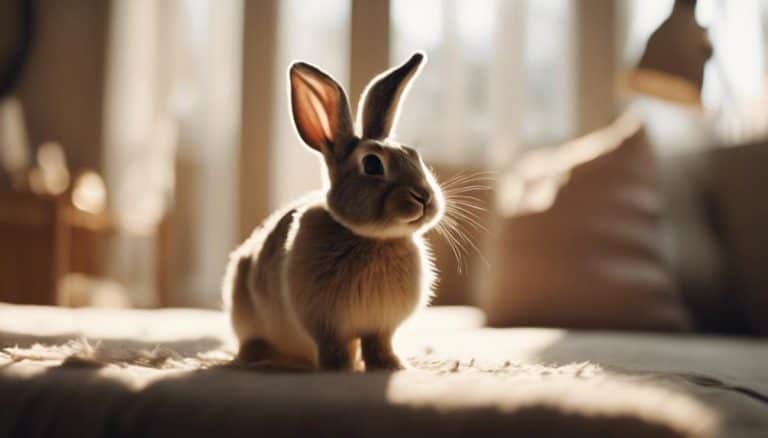Why Is My Pet Rabbit Vibrating?
Have you noticed your pet rabbit vibrating and wondered what’s causing it? This behavior can be unsettling, but it’s important to understand the potential reasons behind it. Your rabbit might be experiencing emotional triggers, stress, or even fear. Alternatively, health issues such as respiratory infections or pain could be the culprits.
Changes in their environment or loud noises might also induce this behavior. Identifying the exact cause is essential for your rabbit’s well-being. So, what should you look out for, and how can you help your furry friend? Let’s explore the possibilities and solutions together.
Emotional Triggers
Emotional triggers like fear or anxiety from loud noises or unfamiliar environments can cause tremors in pet rabbits. You might notice your rabbit shaking or trembling when exposed to sudden, loud sounds or new, unfamiliar settings. These tremors are a physiological response to emotional triggers, signaling that your rabbit is experiencing discomfort or distress.
When diagnosing the cause of your rabbit’s vibrations, consider their environment and any recent changes. Have there been loud noises, such as fireworks or thunderstorms? Has your rabbit been introduced to new surroundings or unfamiliar people? These factors can act as emotional triggers, causing your rabbit to shake.
Furthermore, rabbits may exhibit shaking behavior as a method to seek attention. If your rabbit shakes when you’re nearby, it might be signaling a desire for interaction, such as treats or petting. Recognizing these emotional triggers is essential for understanding your rabbit’s behavior and providing the necessary comfort.
Stress and Anxiety
Addressing the emotional triggers in your rabbit’s environment is just the beginning; understanding and mitigating stress and anxiety is equally important to prevent trembling and shaking behaviors. Stress and anxiety in rabbits can arise from various factors like changes in their environment, loud noises, or sudden movements. These stimuli can cause your rabbit to exhibit shaking or trembling.
To alleviate stress and anxiety, create a quiet and safe space where your rabbit can retreat when feeling overwhelmed. This sanctuary can greatly reduce their stress-induced shaking.
Consulting with a veterinarian is essential for tailored advice on managing your rabbit’s stress and anxiety. They can provide insights into environmental adjustments and behavioral interventions.
Ensure your rabbit’s living environment is secure and free from frequent disturbances. This stability is crucial for minimizing stress and anxiety, subsequently reducing episodes of shaking.
| Stressor | Manifestation | Mitigation Strategy |
|---|---|---|
| Loud noises | Trembling | Soundproofing, white noise |
| Sudden movements | Shaking | Gradual desensitization |
| Environmental changes | Stress behaviors | Consistency, gradual adjustments |
| Lack of safe space | Anxiety | Provide hiding spots |
| Frequent disturbances | Shaking | Maintain a tranquil environment |
Fear Responses
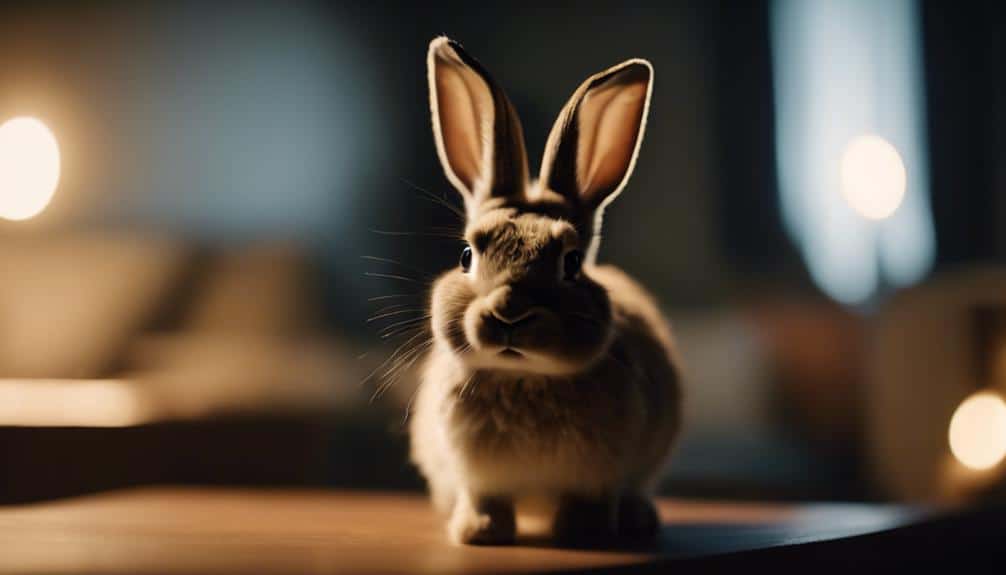
Identifying fear responses in rabbits is essential for effectively managing their shaking and trembling behaviors. When your pet rabbit perceives a threat, it may exhibit fear responses such as shaking, trembling, or quivering. These reactions are typically triggered by loud noises, sudden movements, or unfamiliar environments. Recognizing these signs is vital in mitigating their distress.
To minimize fear responses, make sure your rabbit’s habitat is secure and calm. This involves reducing exposure to startling stimuli and providing familiar, comforting surroundings. Your rabbit might also shake to seek attention or reassurance; observing its body language and behavior will help you identify when it feels scared or anxious.
Health Issues
When your rabbit vibrates, it could signal serious health issues like respiratory infections or neurological disorders.
You should observe for symptoms such as labored breathing or uncoordinated movements, as these are clinical indicators requiring immediate veterinary intervention.
Prompt diagnosis and treatment are essential to address any underlying conditions effectively.
Respiratory Infections
Respiratory infections in rabbits often manifest through clinical signs such as shaking, sneezing, and labored breathing, necessitating prompt veterinary intervention. When your rabbit starts exhibiting these symptoms, it’s important to act promptly. These infections are typically caused by bacteria, viruses, or environmental factors like poor ventilation. If left untreated, they can escalate into more severe conditions like pneumonia, making early diagnosis and treatment crucial.
Veterinarians will perform a thorough physical examination, possibly including diagnostic tests like blood work or radiographs, to identify the underlying cause. Treatment usually involves antibiotics to combat bacterial infections, along with supportive care, such as fluid therapy and nutritional support, to stabilize your pet. Environmental modifications, like improving ventilation and maintaining good hygiene, are also essential to prevent recurrence.
Preventative measures are your best defense. Regular vet check-ups, proper ventilation, and maintaining a clean living space can greatly reduce the risk of respiratory infections. By staying vigilant and proactive, you can ensure your rabbit remains healthy and vibrant. Remember, prompt action can make all the difference in managing and preventing respiratory infections in your beloved pet.
Neurological Disorders
Neurological disorders in rabbits, such as Encephalitozoon cuniculi infection and head tilt, often present with symptoms like head tilt, loss of balance, and abnormal movements, necessitating a thorough diagnostic approach.
Encephalitozoon cuniculi (E. cuniculi) is a parasite that can infect a rabbit’s brain and spinal cord, leading to these debilitating symptoms. You might notice your rabbit tilting its head at an odd angle or having trouble maintaining balance. These signs can be alarming, but they provide critical clues for diagnosis.
Head tilt, also known as torticollis, can result from various causes, including inner ear infections, trauma, or other neurological conditions. To accurately diagnose the issue, your veterinarian will likely perform a series of tests, including blood work, imaging studies, and possibly cerebrospinal fluid analysis. This thorough approach ensures that the underlying cause is identified and appropriately treated.
Treatments for neurological disorders in rabbits generally involve a combination of medication, such as anti-parasitic or anti-inflammatory drugs, and supportive care. Addressing the root cause—whether it’s an infection or another neurological issue—is essential for your rabbit’s recovery. Prompt veterinary attention can greatly improve your pet’s quality of life.
Pain Indicators

When your rabbit exhibits behavioral changes like reduced mobility or appetite, these can be critical indicators of pain. Physical symptoms such as head shaking or shivering often signify underlying health issues that require immediate veterinary consultation.
Behavioral Changes
Identifying pain in rabbits involves closely monitoring for behavioral changes such as hunching, teeth grinding, and decreased activity. These subtle shifts in behavior can be vital indicators of discomfort or pain that may be causing your rabbit to vibrate. Behavioral changes in rabbits can manifest in various ways, and being attuned to these signals is essential for early detection and intervention.
Key signs to watch for include:
- Hunching: A rabbit in pain often adopts a hunched posture to minimize discomfort.
- Teeth Grinding: Also known as bruxism, this can be a sign of severe pain, particularly if loud and frequent.
- Decreased Activity: A sudden lack of interest in play or movement can indicate underlying health issues.
Regular observation of your rabbit’s daily habits is important. Notice any deviations from their typical behavior, such as changes in eating or grooming habits. These behavioral changes can provide valuable clues about their health status.
Engaging with your rabbit and providing a stress-free environment can alleviate some discomfort, but persistent signs necessitate a veterinary consultation. Early diagnosis and treatment can prevent the escalation of pain and safeguard your rabbit’s well-being.
Physical Symptoms
Observing physical symptoms such as head shaking, eye discharge, and reduced appetite can help pinpoint pain sources in your rabbit. Pain-related shaking in rabbits often stems from underlying issues like ear infections or dental problems. Head shaking, for instance, might signal an ear infection causing significant discomfort. Dental issues can also lead to shaking, as pain radiates from the teeth and jaw.
Eye discharge is another critical indicator. Rabbits with eye discharge may be suffering from infections or dental abscesses that need prompt attention. Reduced appetite is particularly concerning. A rabbit that’s not eating may be experiencing gastrointestinal stasis, a condition that leads to severe pain and requires immediate intervention.
Behavioral changes accompany these physical symptoms. Rabbits often hide their discomfort, making it essential to watch for subtle signs.
If you notice your rabbit exhibiting pain-related shaking, reduced appetite, or eye discharge, it’s vital to act swiftly. Early detection and treatment can prevent more severe health issues.
Veterinary Consultation
Prompt veterinary consultation is essential if you notice signs of pain in your rabbit, such as reduced activity, hunched posture, or teeth grinding. These symptoms can indicate significant discomfort, and delaying medical evaluation may exacerbate underlying issues. When your rabbit displays these signs, a professional assessment is critical to identify and treat the cause effectively.
Pain indicators in rabbits can be subtle. Keep an eye out for:
- Changes in eating or drinking habits: A rabbit that suddenly stops eating or drinking might be in pain.
- Reluctance to move: If your rabbit is avoiding movement or seems stiff, it’s a red flag.
- Vocalization during movement: Any unusual sounds when your rabbit moves warrant immediate attention.
A veterinary consultation will involve a thorough examination, possibly including diagnostic imaging or lab tests, to determine the root cause of your rabbit’s discomfort.
Given that rabbits often hide pain, prompt veterinary care is vital for early detection and intervention. Regular check-ups and vigilant observation of your rabbit’s behavior can ensure timely treatment, helping your pet lead a healthy, pain-free life.
Don’t wait—if your rabbit shows any signs of distress, seek veterinary consultation immediately.
Cold Weather
Rabbits may start vibrating in cold weather as a vital response to generate body heat and maintain thermal homeostasis. This shivering mechanism is important for your rabbit’s survival in lower temperatures. When exposed to cold weather, rabbits can appear to vibrate or tremble, which is their body’s way of combating the drop in temperature.
To help your rabbit cope with cold weather, make sure their shelter is properly insulated. Providing adequate bedding and a warm environment can greatly reduce the need for shivering. It’s imperative to monitor the ambient temperature where your rabbit resides and make necessary adjustments to maintain a comfortable climate.
| Cold Weather Conditions | Rabbit’s Response | Preventative Measures |
|---|---|---|
| Low ambient temperature | Shivering/Vibrating | Insulate shelter |
| Drafts in living area | Huddling together | Provide warm bedding |
| Sudden temperature drops | Increased vibrations | Monitor temperature |
Overstimulation

Excessive noise or activity can overwhelm a rabbit’s sensitive nervous system, leading to noticeable vibrating or shaking. Rabbits are highly sensitive creatures, and overstimulation can easily cause them to tremble. To address this, creating a calm and quiet environment is vital. Overstimulated rabbits can exhibit trembling as a physiological response to their overwhelmed state.
To prevent overstimulation, consider the following:
- Limit loud noises: Keep your rabbit’s environment free from sudden, loud sounds.
- Minimize sudden movements: Avoid quick, unexpected actions around your rabbit.
- Reduce crowded spaces: Ensure your rabbit has a spacious, serene area to retreat to.
Monitoring your rabbit’s reactions to various environmental stimuli can provide important insights. If you notice your rabbit shaking, assess their surroundings for potential overstimulation triggers.
For instance, are there frequent loud noises from household activities or external sources like traffic? Are there too many people or animals moving around the rabbit’s space?
Diet and Nutrition
A well-balanced diet, comprising primarily of 80% hay, is essential for maintaining your rabbit’s best digestive and dental health. Hay not only aids in proper digestion but also helps to wear down your rabbit’s continuously growing teeth. Fresh vegetables such as cabbage and zucchini should make up a significant portion of the remaining 20%, offering crucial nutrients and hydration.
However, fruits like strawberries and blueberries should be limited to occasional treats due to their high sugar content. Too much sugar can disrupt your rabbit’s gut flora, leading to potential digestive issues. Always avoid high-sugar or starchy foods such as bread, cookies, or crackers, as they can cause harmful gastrointestinal problems.
Here’s a quick reference table to guide you:
| Food Type | Recommendation |
|---|---|
| Hay | 80% of diet |
| Fresh Vegetables | Essential for nutrients (e.g., cabbage, zucchini) |
| Fruits | Treats in moderation (e.g., strawberries, blueberries) |
Ensure that fresh water is always available, as dehydration can lead to severe health complications. By adhering to these guidelines, you can create a rabbit diet that promotes crucial health, reducing the likelihood of issues that might cause your pet to vibrate or exhibit other signs of distress.
Seeking Professional Help
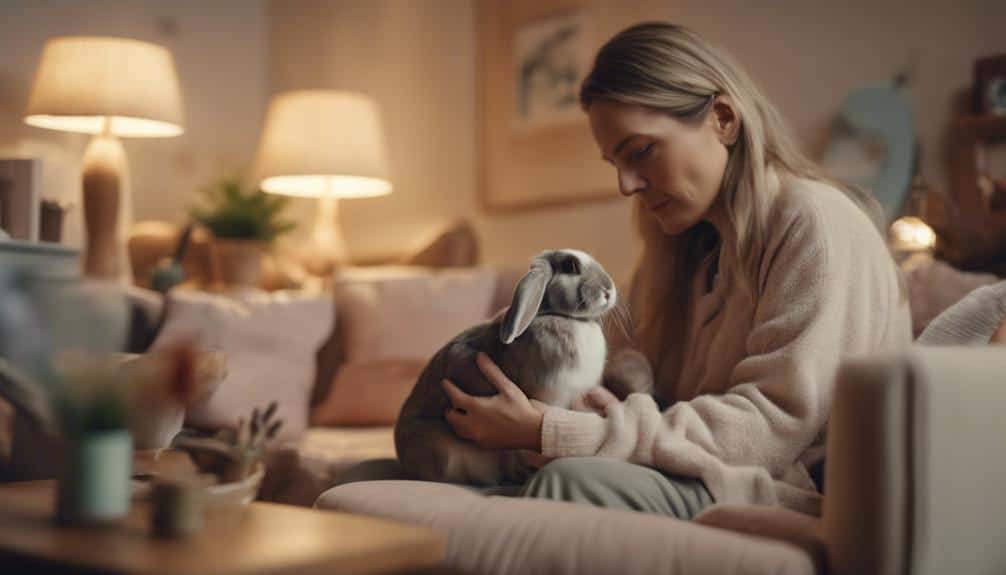
If your rabbit continues to exhibit persistent shaking despite adhering to a well-balanced diet, immediate veterinary attention is imperative. Persistent shaking can be a sign of underlying health issues that require a professional diagnosis. Contact Yalesville Veterinary Hospital or your local vet to schedule an appointment.
A thorough examination by a veterinarian is vital to identify the root cause of your rabbit’s shaking.
Additional symptoms to monitor include:
- Labored breathing
- Reduced activity level
- Changes in appetite
These signs can indicate serious conditions such as infections, neurological disorders, or metabolic imbalances. The veterinarian will likely conduct a physical examination, possibly followed by diagnostic tests like blood work or imaging studies. This all-encompassing approach ensures that any health issues contributing to the shaking are accurately identified and promptly treated.
Prompt treatment is essential to address the underlying cause and improve your rabbit’s quality of life. Don’t delay seeking professional help, as early intervention can make a significant difference.
Ensuring your rabbit receives the appropriate medical care will help alleviate their discomfort and prevent any potential complications. Your proactive approach is vital for your pet’s well-being.
Conclusion
If your rabbit’s vibrating, it’s important to closely monitor its behavior and environment. Emotional triggers, stress, fear, and health issues like respiratory infections or pain are common causes.
Guarantee a calm, secure living space and consider factors like cold weather, overstimulation, and diet.
If the shaking persists, consult a veterinarian for a thorough diagnostic evaluation. Timely intervention is essential to address potential underlying conditions and ensure your rabbit’s well-being.


